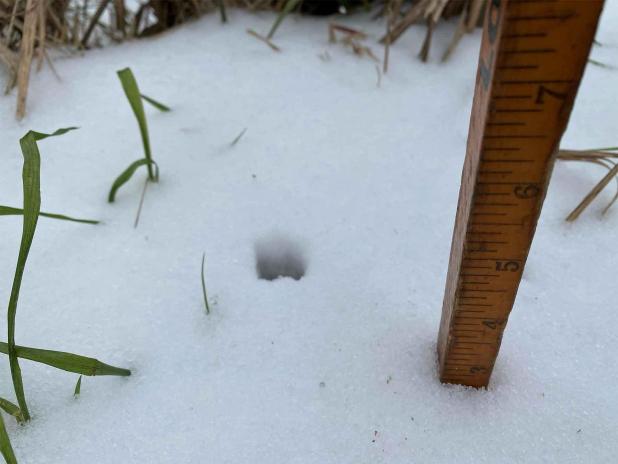
Nearly 3 inches of snow and ice cover a sugar cane row on Fletcher Bubenzer’s farm near Bunkie. Louisiana had more than 60 hours of subfreezing temperatures, including record low temperatures in the low teens across much of the northern sugar cane growing regions.
Submitted Photo/Fletcher Bubenzer
Farmers wait to see if freeze damaged sugar cane
More than 60 hours of subfreezing temperatures, including lows in the mid- to lower teens in the northern region of the Louisiana sugar cane belt, has many growers concerned about the effects it will have on next year’s crop.
LSU AgCenter sugarcane specialist Kenneth Gravois has been monitoring the situation across the growing area and is optimistic the damage is not too severe. Like most severe weather events, it may take a while before a complete and accurate assessment can be made.
“Every freeze has its own story, so we’re going to uncover that story in the days and weeks to come,” Gravois said.
Gravois referred to a similar scenario that occurred in January 2018 when consecutive nighttime lows reached 14 and 17 degrees Fahrenheit.
“That was cold consecutive days for low temperatures. The cane crop survived that just fine,” he said.
AgCenter engineer Randy Price monitors soil depth temperatures at several weather stations across the state. Price found the soil temperatures at the Dean Lee Research and Extension Center near Alexandria did not reach freezing, checking in at 34 degrees at a 2-inch depth.
Louisiana produced nearly 2 million tons of sugar this year, which is the largest crop on record. Increased acreage in the northern and western sugar cane-growing areas contributed to the crop reaching record size. Cane grown in the northern area is more vulnerable to freezing conditions.
Gravois said the weather preceding the freeze provided some protection for the crop.
“We did have rainfall and a lot of snowfall before the freeze,” he said. “That snow is going to act as a temperature buffer.”
Gravois said this freeze was nowhere near as devastating as the December 1989 freeze. The weather was not nearly as cold compared to 1989, and varieties developed during the past 30 years are more cold tolerant.
Gravois also said this was not the worst February freeze for Louisiana’s sugar cane crop.
“The February freeze of 1899 brought 6 inches of snow to New Orleans,” he said. “This was no February of 1899 freeze.”
